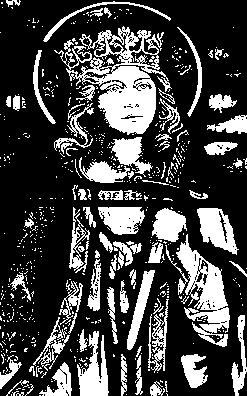Related Research Articles
Ceredig ap Cunedda, was king of Ceredigion in Wales.

Saint Tydfil is the legendary dedicatee of Merthyr Tydfil, Wales. The old parish church of St Tydfil, Merthyr Tydfil is dedicated to her and is reputed to be the site of her death.

Brychan Brycheiniog was a legendary 5th-century king of Brycheiniog in Mid Wales.

Keyne was a 5th-century holy woman and hermitess who was said to have traveled widely through what is now South Wales and Cornwall.

Saint Dwynwen, sometimes known as Dwyn or Donwen, is the Welsh patron saint of lovers. She is celebrated throughout Wales on 25 January.

Brycheiniog was an independent kingdom in South Wales in the Early Middle Ages. It allied with the Mercian Kingdom in the post Roman era, to stabilise and control a central (Marches) area key to dominance over central Proto-England to the east and the south Welsh kingdom of Deheubarth to the west. It was conquered and pacified by the Amorican Normans between 1088 and 1095, though it remained Welsh in character. It was transformed into the Lordship of Brecknock and later formed the southern and larger part of the historic county of Brecknockshire. To its south was the Kingdom of Morgannwg.

Saint Oudoceus (Latin) or Euddogwy (Welsh) is generally known as the third Bishop of Llandaff in South Wales. In reality he was probably a 7th-century bishop at Llandeilo Fawr. Wendy Davies puts his episcopal reign between about 650 and 700.

Mabyn, also known as Mabena, Mabon, etc., was a medieval Cornish saint. According to local Cornish tradition she was one of the many children of Brychan, king of Brycheiniog in Wales in the 5th century. The village and civil parish of St Mabyn is named for her, and the local St Mabyn Parish Church is dedicated to her.

Saint Teilo, also known by his Cornish name Eliud, was a British Christian monk, bishop, and founder of monasteries and churches. He was from Penalun (Penally) near Tenby in Pembrokeshire, south Wales.
Isfael or Ismael, often anglicized as Ishmael, was a 6th-century medieval Welsh bishop of Rhos and saint. He was allegedly also a Breton prince of Armorica.
Jacut was a 5th-century Cornish Saint who worked in Brittany. He is commemorated liturgically on 6 February.
Adwen or Adwenna was a 5th-century Christian virgin and saint. She is recorded as a daughter of Brychan, king of Brycheiniog in south Wales, in the Cornish Life of Saint Nectan and in Robert Hunt's collection of Cornish legends. These sources associate her with the establishment of the parish of Advent in Cornwall.

Tetha, also known as Teath, Tecla, and by a variety of other names, was a 5th-century virgin and saint in Wales and Cornwall. She is associated with the parish church of St Teath in Cornwall. Baring-Gould gives her feast day as 27 October, but this has been called a mistaken conflation with Saint Ia. In 1878, it was held on the movable feast of Whit Tuesday. Other sources place it on 1 May, 6 September, and (mistakenly) 15 January. It is no longer observed by either the Anglican or Catholic church in Wales.
Arthfael Hen ap Rhys, also called Arthfael the Old, was the king of the Kingdom of Glywysing between 785 and approximately 825 AD.
Cynyr Ceinfarfog was a ruler of the Kingdom of Dyfed in Wales. He was known as Cunoricus in Latin and in English as Kendrick or as Cynyr the Red.

St. Maches was a 6th-century princess and Pre-congregational saint of Cornwall and Devon. Maches was the sister of St. Cadog.

Cyfyw was a 6th-century princess and pre-congregational Saint of Cornwall and Wales. She was the sister of St. Cadoc Cynidr and Maches.
Egwine was a 6th-century Celtic princess and saint, who is a patron saint of the village of Llanigon, east of Hay-on-Wye, in the Wye Valley of Wales.
Saint Dogmael was a 6th-century Welsh monk and preacher who is considered a saint. His feast day is 14 June.
Saint Meleri was a late 5th century Welsh saint and Queen of Ceredigion.
References
- ↑ Thornton, David E. "Brychan Brycheiniog (fl. c. 500)". Oxford Dictionary of National Biography . Oxford University Press, 2004.
- ↑ Wade-Evans, A. W. "The Brychan documents". ( Y Cymmrodor 19, 1906) pages18–50.
- ↑ Family Card – Person Sheet (Rigrawst).
- ↑ Brian Daniel Starr, The Life of Saint Brychan: King of Brycheiniog and Family (Google eBook) (Brian Daniel Starr, 2008) page 59.
- ↑ She is thus a descendant of Constantine the Great and Saint Helen.
- ↑ Rachel Bromwich, Trioedd Ynys Prydein: The Welsh Triads. Cardiff: University of Wales Press, Third Edition, 2006. 441–444.
- ↑ According to the legend she is also a descendant of Joseph of Arimathea, although this is unlikely.
- ↑ Brian Daniel Starr, The Life of Saint Brychan: King of Brycheiniog and Family (Google eBook) (Brian Daniel Starr, 2008) page 59.